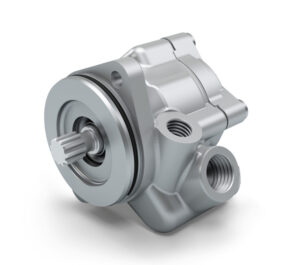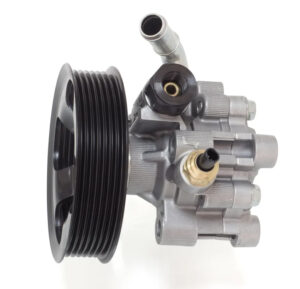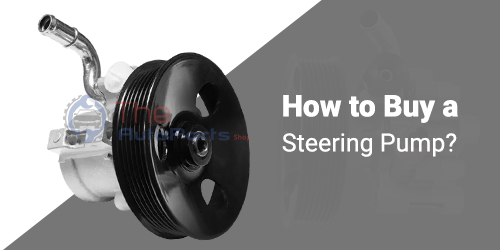Many individuals consider the steering pump a magical box that gives an exhilarating driving experience to an individual. The main question is how the steering pump performs all this work. Let us get into the detailed working of the steering pump and continue reading the article as we have come up with the answer of “How to Buy a Power Steering Pump?”
What Exactly is a Power Steering Pump?

The automobile consists of a steering system with a steering rack and a power steering pump. Their combined effort offers effortless steering. In formal terms, a steering pump is basically a centrifugal vane-type hydraulic pump that provides pressure to the steering fluid via high-speed rotations. It is also responsible for creating power differential, thereby offering “Power Assist” to the vehicle’s steering system.
How Does a Power Steering Pump Work?
In a true sense, the power steering pump is the “primary” component of the steering system. It plays a similar role as the “Heart” in the human body. Various mechanisms take place for the smooth working of the steering pump. Things could become more complex, especially when someone has no prior knowledge about the power steering pump.
The working of the steering pump has been divided into three main categories:
- Before steering pump
- Within Steering Pump
- After Steering Pump
Before Steering Pump
The moment you open the hood of your vehicle, you’ll come across a yellowish container with a power steering pump written on it. This is the container where the steering fluid is added. Similarly, the petrol is filled in the petrol tank, an addition of the power steering fluid is added to the steering fluid tank.
The major role of the tank is to keep the steering fluid and supply it to the entire pump using a rubber hose. Fluid no longer in use stays as it is in the reservoir. When we need a steering fluid, it is taken out of a reservoir and is delivered to that place.
Now is the time for the steering pump to spin. Cranking is only possible with the continuous supply of power which is generated by the vehicle itself. The engine produces power by combining the mixture of air and petrol via electric sparks. The mixture of petrol and air ignites within the engine and dissipates energy that pushes the piston up and down. The piston is attached to the crankshaft, which harvests energy and it begins to rotate. Lastly, an engine belt is placed around the rotating crankshaft, which is connected to the pulley. The moment we start, the car engine starts pulling the steering pump pulley, and the steering pump pulley starts moving.
Within the Steering Pump
At this point, the steering pump starts moving, and the steering fluid is delivered to the pump. Next, the pressure is given to the steering fluid. Let us get into the ins and outs of the steering pump and how the device generates the high-pressure fluid. The steering pump consists of three different items named the housing, rotor, and vane.
The rotor is a solid block made up of metal and has a hollow hole in the center accompanied by the cavities present in the external region. Both of them serve a distinct purpose.
The hole present in the center has a direct connection with the steering pump pulley via cylindrical metal. As the steering pump pulley rotates, the rotor starts moving; this is why it has been named “Rotor.”
After Steering Pump
Let us dive deeper into the functioning of the after the steering pump. The high-pressure steering pump delivers the steering pump into the rack. The steering pump has been divided into two basic chambers, the left one and the right one.
As the steering fluid gets into the hydraulic chambers, the steering fluid is divided so that one chamber receives more than another. If the left chamber gets more fluid, it becomes robust than the one present at the right. The steering rack moves to the right because of the distinction in the fluid pressure.
Power assist is the driving force behind the movement. This is the primary reason which makes the steering feel lightweight despite the power steering system present in the vehicle. The steering fluid leaves the steering rack through the hose and goes back to the steering fluid reservoir.
The process keeps on repeating itself till the time the engine is switched off.
How To Determine That The Steering Pump Has Gone Bad?

Check the steering pump for the following symptoms which indicate that it has gone bad:
Whining Noises Produced by Vehicle on Turning the Wheel
If your vehicle starts making whining noises, a possible reason could be a leak in the power steering pump. Chances are there that the power steering fluid level is low. A noisy power steering is a problem every motorist wants to avoid. It is better to have a look at the steering fluid level, and if the level is fine, it is better to take it to the mechanic for an inspection.
Slow Response from the Car Steering Wheel
The response must come from the car the moment the wheel is turned. If the steering responds slower than usual, know that there are issues, and it’s time to replace the steering pump.
Stiff Steering Wheel
Problems with the steering pump make it difficult for you to turn the vehicle. It is better to take it to the mechanic and know the power steering pump cost before getting it replaced.
Squealing Noises while Turning the Ignition On
If your vehicle starts making squealing noises the moment you start the car, know that there are issues with the steering pump. These issues occur when you start making sharp turns. It is better to get the steering pump inspected by the technician and get issues resolved from him.
Groaning Noises Produced by the Car
Groaning noises are quite loud and irritating and must be resolved immediately. Faulty steering pump and other car issues are the leading cause behind this issue. Find out the reason and replace the power steering pump.
How to Buy a Steering Pump?
Finding the steering pump by entering the year, make, and model is a hassle for many. You can still find the right part by entering the OEM number and finding the right part. Call your dealership and share the VIN number to get the desired part.
The Bottom Line
Determine the root cause behind the problematic steering pump and try to eradicate them. Problems persisting for extended durations can impair the working of the car.
